More Energy and Less Work, but New Crises: How the Societal Metabolism-Labour Nexus Changes from Agrarian to Industrial Societies
Abstract
:1. Introduction: Human Labour and the Sociometabolic Transition
2. The Social Metabolism-Labour-Nexus
- (A)
- Societal stocks: human population, domesticated animals, colonized land and man-made artefacts.
- (B)
- Sociometabolic material flows like extraction, trade flows and material consumption.
- (C)
- Primary energy and useful energy related to human labour, animal labour and technology.
3. Methods Used and Data Sources
3.1 Material Flow Accounting (MFA)
3.1.1. Methodological and Conceptual Considerations
3.1.2. Surveys and Data
3.2. Primary and Useful Energy
3.3. Carbon Emissions
4. No Time: Insights into an Agrarian Society of the Ethiopian Bashkurit Valley
4.1. Societal Stocks: People, Livestocks, Land and Artifacts
4.2. Metabolic Flows of a Valley in an Agrarian Society
4.3. Primary Energy, Societal Useful Energy and Human Labour
4.4. An Intermediate Resume: Built-In Dynamics of the Societal Metabolism-Labour Nexus
5. Energy in Abundance: A village in Industrialized Lower Austria
5.1. Societal Stocks: People, Animals, Land and Artifacts
5.2. Metabolic Flows of a Rural Village in an Industrial Society
5.3. Primary Energy, Societal Useful Energy and Human Labour
6. Changes in the Societal Metabolism-Labour Nexus across Energy Regimes
Acknowledgments
Author Contributions
Conflicts of Interest
References
- Rockström, J.; Steffen, W.; Noone, K.; Persson, Å.; Chapin, F.S.; Lambin, E.F.; Lenton, T.M.; Scheffer, M.; Folke, C.; Schellnhuber, H.J.; et al. A safe operating space for humanity. Nature 2009, 461, 472–475. [Google Scholar] [CrossRef] [PubMed]
- Crutzen, P.J.; Stoermer, E.F. The “Anthropocene”. IGBP Newsl. 2000, 41, 17–18. [Google Scholar]
- Fischer-Kowalski, M.; Krausmann, F.; Pallua, I. A sociometabolic reading of the Anthropocene: Modes of subsistence, population size and human impact on Earth. Anthr. Rev. 2014, 1, 8–33. [Google Scholar] [CrossRef]
- Sieferle, R.P. The Subterranean Forest: Energy Systems and The Industrial Revolution; White Horse Press: Cambridge, UK, 2001. [Google Scholar]
- Haberl, H.; Fischer-Kowalski, M.; Krausmann, F.; Martinez-Alier, J.; Winiwarter, V. A socio-metabolic transition towards sustainability? Challenges for another Great Transformation. Sustain. Dev. 2011, 19, 1–14. [Google Scholar] [CrossRef]
- Fischer-Kowalski, M.; Haas, W. Exploring the transformation of human labour in relation to socio-ecological transitions. In Let’s Get to Work! The Future of Labour in Europe; Beblavy, M., Maselli, I., Veselková, M., Eds.; Centre for European Policy Studies (CEPS): Brussels, Belgium, 2014; Volume 1, p. 250. [Google Scholar]
- Fischer-Kowalski, M.; Weisz, H. The Archipelago of Social Ecology and the Island of the Vienna School. In Social Ecology: Society-Nature Relations across Time and Space; Springer: Cham, Switzerland, 2016; pp. 3–28. [Google Scholar]
- Fischer-Kowalski, M.; Weisz, H. Society as hybrid between material and symbolic realms. Adv. Hum. Ecol. 1999, 8, 215–251. [Google Scholar]
- De Molina Navarro, M.G.; Toledo, V.M. The Social Metabolism: A Socio-Ecological Theory of Historical Change; Springer: Cham, Switzerland, 2014. [Google Scholar]
- Fischer-Kowalski, M.; Haberl, H. Tons, joules, and money: Modes of production and their sustainability problems. Soc. Nat. Resour. 1997, 10, 61–85. [Google Scholar] [CrossRef]
- Matthews, E.; Amann, C.; Bringezu, S.; Hüttler, W.; Ottke, C.; Rodenburg, E.; Rogich, D.; Schandl, H.; Van, E.; Voet, D.; et al. The Weight of Nations-Material Outflows from Industrial Economies; World Resources Institute: Washington, DC, USA, 2000. [Google Scholar]
- Marx, K. Die Produktion des absoluten Mehrwerts. 5. Kap. Arbeitsprozess und Verwertungsprozess. K Marx F Engels Werke 1968, 23, 192–213. [Google Scholar]
- Haberl, H.; Zangerl-Weisz, H. Kolonisierende Eingriffe: Systematik und Wirkweise. In Gesellschaftlicher Stoffwechsel und Kolonisierung von Natur: Ein Versuch in Sozialer Ökologie; Fischer-Kowalski, M., Fischer Kowalski, M., Eds.; Overseas Publ. Association (OPA): Amsterdam, The Netherlands, 1997. [Google Scholar]
- Pimentel, D.; Acquay, H.; Biltonen, M.; Rice, P.; Silva, M.; Nelson, J.; Lipner, V.; Giordano, S.; Horowitz, A.; D’Amore, M. Environmental and Economic Costs of Pesticide Use. BioScience 1992, 42, 750–760. [Google Scholar] [CrossRef]
- Tilman, D.; Cassman, K.G.; Matson, P.A.; Naylor, R.; Polasky, S. Agricultural sustainability and intensive production practices. Nature 2002, 418, 671–677. [Google Scholar] [CrossRef] [PubMed]
- Markussen, M.; Østergård, H. Energy Analysis of the Danish Food Production System: Food-EROI and Fossil Fuel Dependency. Energies 2013, 6, 4170–4186. [Google Scholar] [CrossRef]
- Pimentel, D.; Hurd, L.E.; Bellotti, A.C.; Forster, M.J.; Oka, I.N.; Sholes, O.D.; Whitman, R.J. Food Production and the Energy Crisis. Science 1973, 182, 443–449. [Google Scholar] [CrossRef] [PubMed]
- Sieferle, R.P. Rückblick auf Die Natur: Eine Geschichte des Menschen und Seiner Umwelt; Luchterhand: München, Germany, 1997. [Google Scholar]
- Fischer-Kowalski, M.; Haberl, H. Socioecological Transitions and Global Change: Trajectories of Social Metabolism and Land Use; Edward Elgar Publishing: Cheltenham, UK, 2007. [Google Scholar]
- Haberl, H. The Energetic Metabolism of Societies: Part II: Empirical Examples. J. Ind. Ecol. 2001, 5, 71–88. [Google Scholar] [CrossRef]
- Fields, G. Urbanization and the transition from agrarian to industrial society. Berkeley Plan. J. 1999, 13, 102–128. [Google Scholar]
- Fischer-Kowalski, M.; Haas, W. Toward a Socioecological Concept of Human Labor. In Social Ecology: Society-Nature Relations across Time and Space; Haberl, H., Fischer-Kowalski, M., Krausmann, F., Winiwarter, V., Eds.; Springer: Cham, Switzerland, 2016; pp. 259–276. [Google Scholar]
- Eurostat. Economy-Wide Material Flow Accounts (EW-MFA)—Compilation Guide 2013; Eurostat: Luxembourg, 2013; p. 87. [Google Scholar]
- Krausmann, F.; Weisz, H.; Eisenmenger, N.; Schütz, H.; Haas, W.; Schaffartzik, A. Economy-Wide Material Flow Accounting Introduction and Guide; Institute of Social Ecology: Vienna, Austria, 2015. [Google Scholar]
- Fischer-Kowalski, M.; Krausmann, F.; Giljum, S.; Lutter, S.; Mayer, A.; Bringezu, S.; Moriguchi, Y.; Schütz, H.; Schandl, H.; Weisz, H. Methodology and indicators of economy-wide material flow accounting. J. Ind. Ecol. 2011, 15, 855–876. [Google Scholar] [CrossRef]
- Singh, S.J.; Ringhofer, L.; Haas, W.; Krausmann, F.; Lauk, C.; Fischer-Kowalski, M. Local Studies Manual: A Researcher’s Guide for Investigating the Social Metabolism of Rural Systems; Social Ecology Working Paper; Institute of Social Ecology: Vienna, Austria, 2010. [Google Scholar]
- Andarge, H.B. People, Energy, and Environment—A Socio-Ecological Analysis in Bashkurit Watershed, Ethiopia. Ph.D. Dissertation, Alpen Adria Universitaet, Klagenfurt, Austria, 2014. [Google Scholar]
- Haas, W.; Krausmann, F. Transition-related changes in the metabolic profile of an Austrian rural village. Work. Soc. Ecol. 2015, 153, 42. [Google Scholar]
- Zabalza Bribián, I.; Valero Capilla, A.; Aranda Usón, A. Life cycle assessment of building materials: Comparative analysis of energy and environmental impacts and evaluation of the eco-efficiency improvement potential. Build. Environ. 2011, 46, 1133–1140. [Google Scholar] [CrossRef]
- Haberl, H. The energetic metabolism of societies: Part I: Accounting concepts. J. Ind. Ecol. 2001, 5, 11–33. [Google Scholar] [CrossRef]
- Brockway, P.E.; Barrett, J.R.; Foxon, T.J.; Steinberger, J.K. Divergence of Trends in US and UK Aggregate Exergy Efficiencies 1960–2010. Environ. Sci. Technol. 2014, 48, 9874–9881. [Google Scholar] [CrossRef] [PubMed]
- Rant, Z. Exergie, ein neues Wort fur “Technische Arbeitsfaehigkeit”(Exergy, a new word for technical availability). Forsch. Auf Dem Geb. Ingenieurwesens A 1956, 22, 36–37. [Google Scholar]
- Smil, V. Agricultural energy costs: National analyses. In Energy Farm Production; Fluck, R.C., Ed.; Elsevier: Amsterdam, The Netherlands, 1992; pp. 85–100. [Google Scholar]
- Smil, V. Energy Transitions: History, Requirements, Prospects; ABC-CLIO: Santa Barbara, CA, USA, 2010. [Google Scholar]
- Hammond, G.; Stapleton, A. Exergy analysis of the United Kingdom energy system. Proc. Inst. Mech. Eng. Part J. Power Energy 2001, 215, 141–162. [Google Scholar] [CrossRef]
- Geller, H.S. Cooking in the ungra area: Fuel efficiency, energy losses, and opportunities for reducing firewood consumption. Biomass 1982, 2, 83–101. [Google Scholar] [CrossRef]
- CO2-Calculator. Available online: http://www.energyglobe.com/de_at/haus-wohnung/energiesparen-im-haushalt/online-checks-zum-thema/co2-rechner/ (accessed on 1 May 2017).
- FAOSTAT Macro Indicators. Available online: http://www.fao.org/faostat/en/#data/MK (accessed on 21 April 2017).
- Asrat, F. Ethiopia Country Report for the 2014 Ministerial Conference on Youth Employment; Federal TVET Agency, Ministry of Education: Addis Ababa, Ethiopia, 2014. [Google Scholar]
- Mayer, A.; Schaffartzik, A.; Haas, W.; Rojas-Sepulveda, A.; World Rainforest Movement; GRAIN; Brad, A.; Pichler, M.; Plank, C.; Andarge, H.B. Patterns of Global Biomass Trade—Implications for Food Sovereignty and Socio-Environmental Conflicts; EJOLT Report No. 20; ICTA, Universitat Autonoma de Barcelona: Barcelona, Spain, 2014. [Google Scholar]
- Salomon, J.A.; Wang, H.; Freeman, M.K.; Vos, T.; Flaxman, A.D.; Lopez, A.D.; Murray, C.J. Healthy life expectancy for 187 countries, 1990–2010: A systematic analysis for the Global Burden Disease Study 2010. Lancet 2013, 380, 2144–2162. [Google Scholar] [CrossRef]
- Wiedenhofer, D.; Steinberger, J.K.; Eisenmenger, N.; Haas, W. Maintenance and Expansion: Modeling Material Stocks and Flows for Residential Buildings and Transportation Networks in the EU25: Stocks and Flows in the EU25. J. Ind. Ecol. 2015, 19, 538–551. [Google Scholar] [CrossRef] [PubMed]
- FAO/WHO/UNU. Expert Consultation Human Energy Requirements 2001; Food and Agriculture Organization of the United Nations: Rome, Italy, 2011. [Google Scholar]
- Ringhofer, L.; Fischer-Kowalski, M. Method Box: Functional Time Use Analysis. In Social Ecology: Society-Nature Relations across Time and Space; Haberl, H., Fischer-Kowalski, M., Krausmann, F., Winiwarter, V., Eds.; Springer: Cham, Switzerland, 2016; pp. 519–522. [Google Scholar]
- Fischer-Kowalski, M.; Singh, S.J.; Lauk, C.; Remesch, A.; Ringhofer, L.; Grünbühel, C.M. Sociometabolic transitions in subsistence communities: Boserup revisited in four comparative case studies. Hum. Ecol. Rev. 2011, 18, 147–158. [Google Scholar]
- Utlu, Z.; Hepbasli, A. Estimating the energy and exergy utilization efficiencies for the residential–commercial sector: An application. Energy Policy 2006, 34, 1097–1105. [Google Scholar] [CrossRef]
- Boserup, E. The Conditions of Agricultural Growth. The Economics of Agrarian Change under Population Pressure; Aldine/Earthscan: Chicago, IL, USA, 1965. [Google Scholar]
- Statistik Austria Erwerbsstatistik Nach Wirtschaftssektoren. Available online: http://www.statistik.at/web_de/services/statcube/index.html (accessed on 21 April 2017).
- Statistik Austria Bevölkerung nach Lebensunterhalt und Geschlecht seit 1994. Available online: http://www.statistik.at/web_de/statistiken/menschen_und_gesellschaft/arbeitsmarkt/erwerbsstatus/index.html (accessed on 9 January 2017).
- Statistik Austria Bevölkerung am 1.1.2016 nach Ortschaften. Available online: http://www.statistik.at/wcm/idc/idcplg?IdcService=GET_PDF_FILE&RevisionSelectionMethod=LatestReleased&dDocName=103419 (accessed on 13 January 2017).
- Statistik Austria Ortsverzeichnis Niederösterreich. 2005. Available online: https://www.statistik.at/wcm/idc/idcplg?IdcService=GET_PDF_FILE&RevisionSelectionMethod=LatestReleased&dDocName=007110 (accessed on 13 January 2017).
- Eisenmenger, N.; Fridolin, K.; Milota, E.; Schaffartzik, A. Ressourcennutzung in Österreich–Bericht 2011; Bundesminist. Für Land- Forstwirtsch. Umw. Wasserwirtsch. Bundesminist. Für Wirtsch. Fam. Jugend Wien: Wien, Austria, 2011. [Google Scholar]
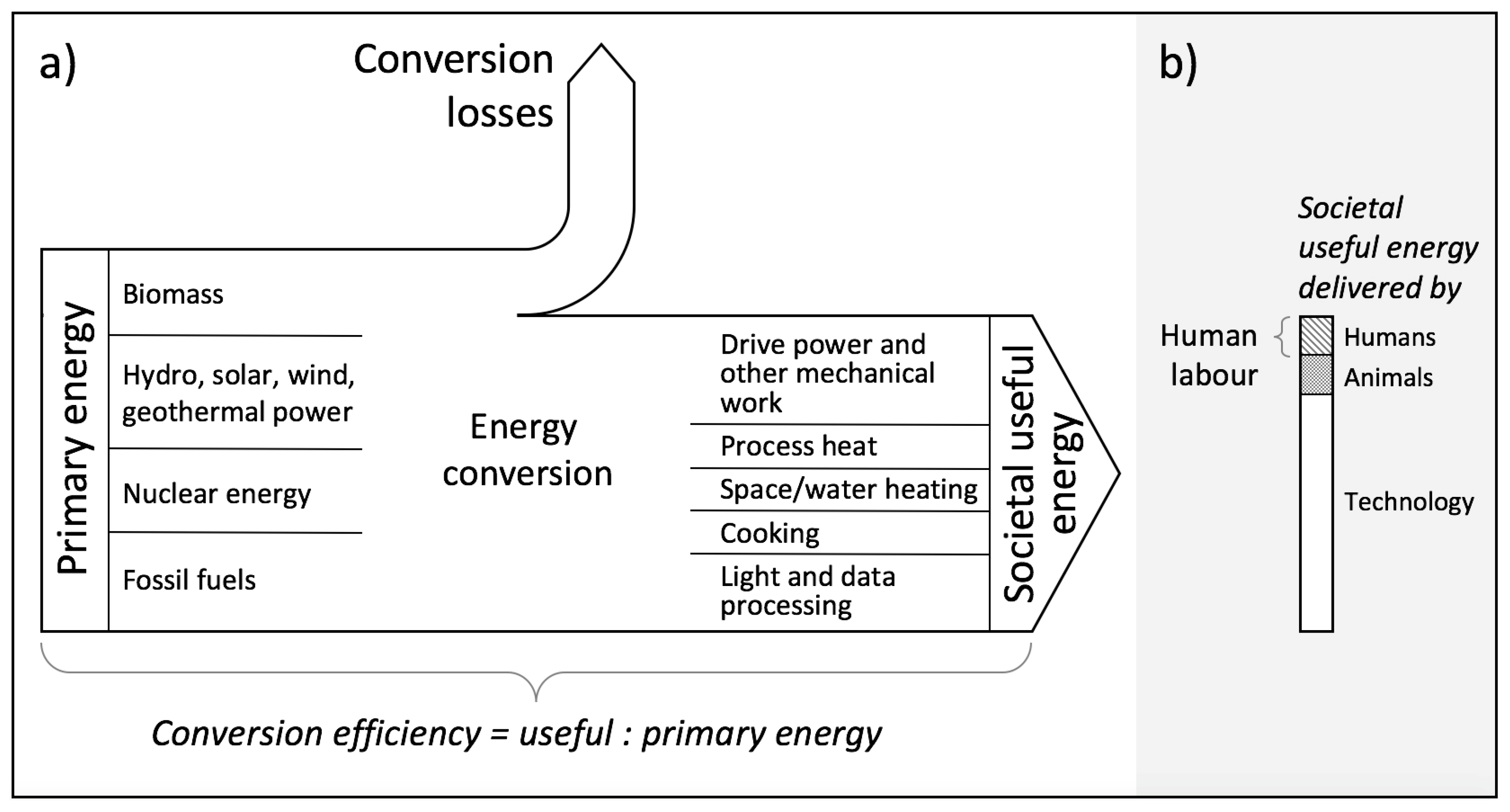

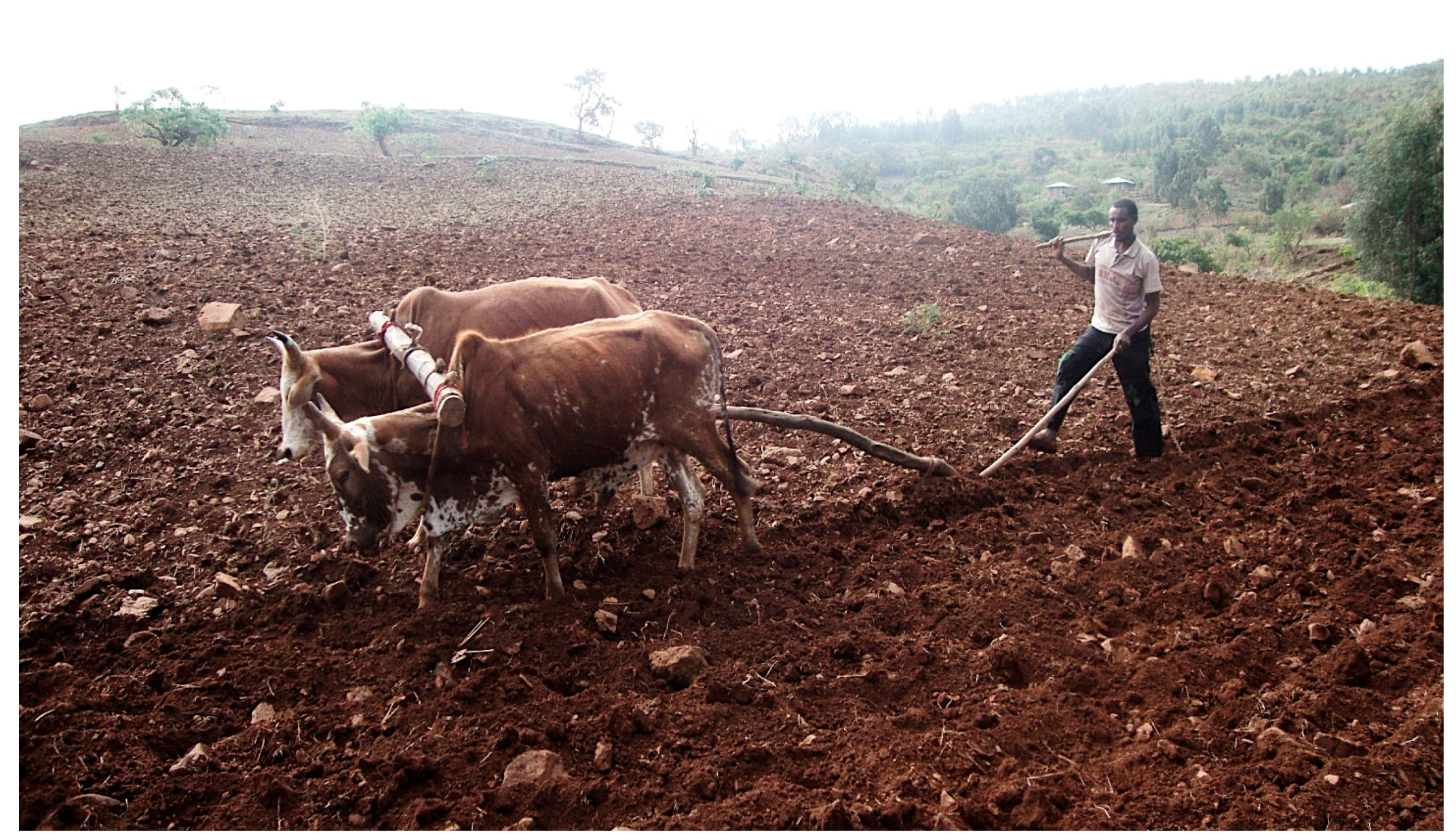
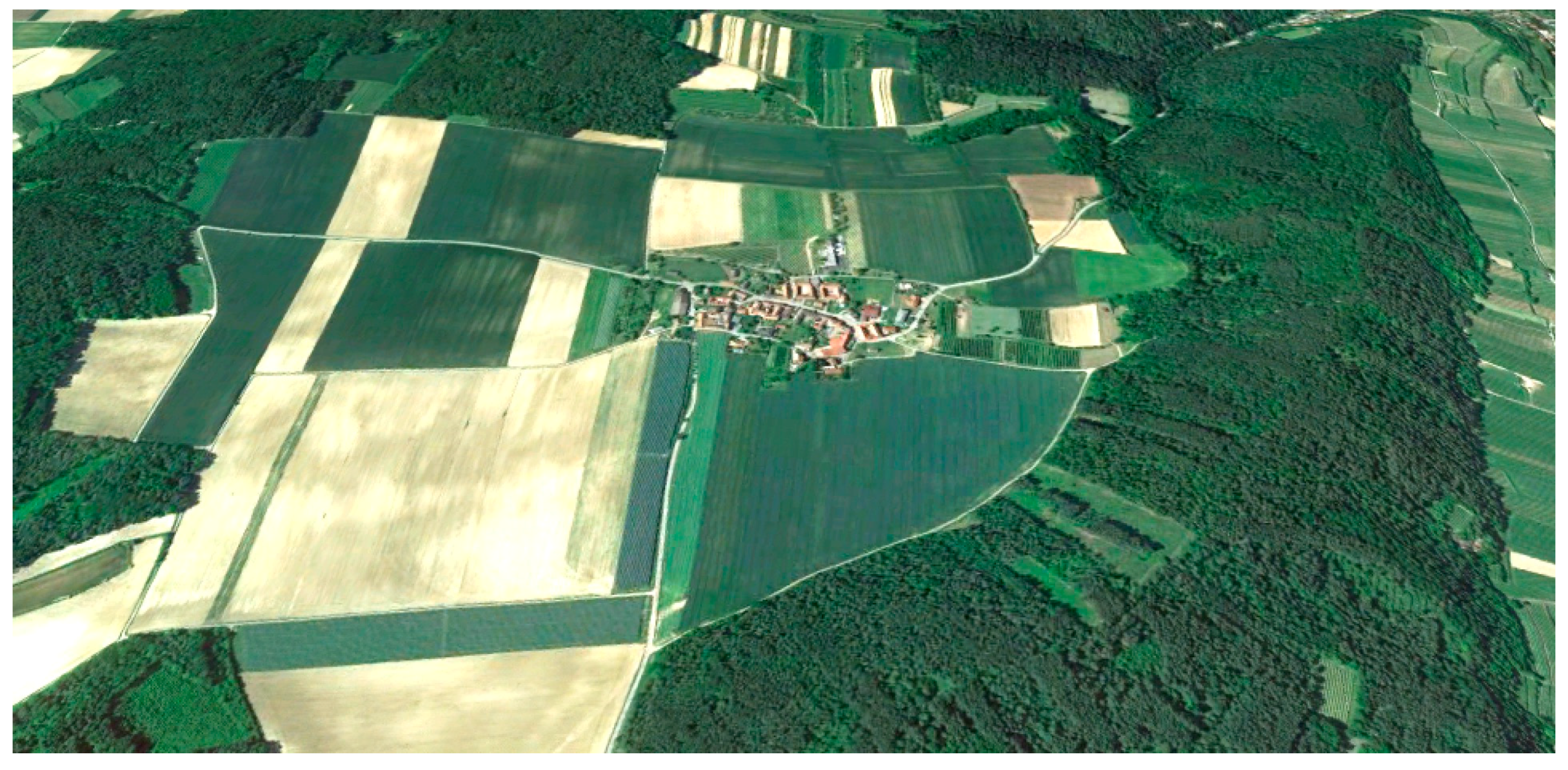
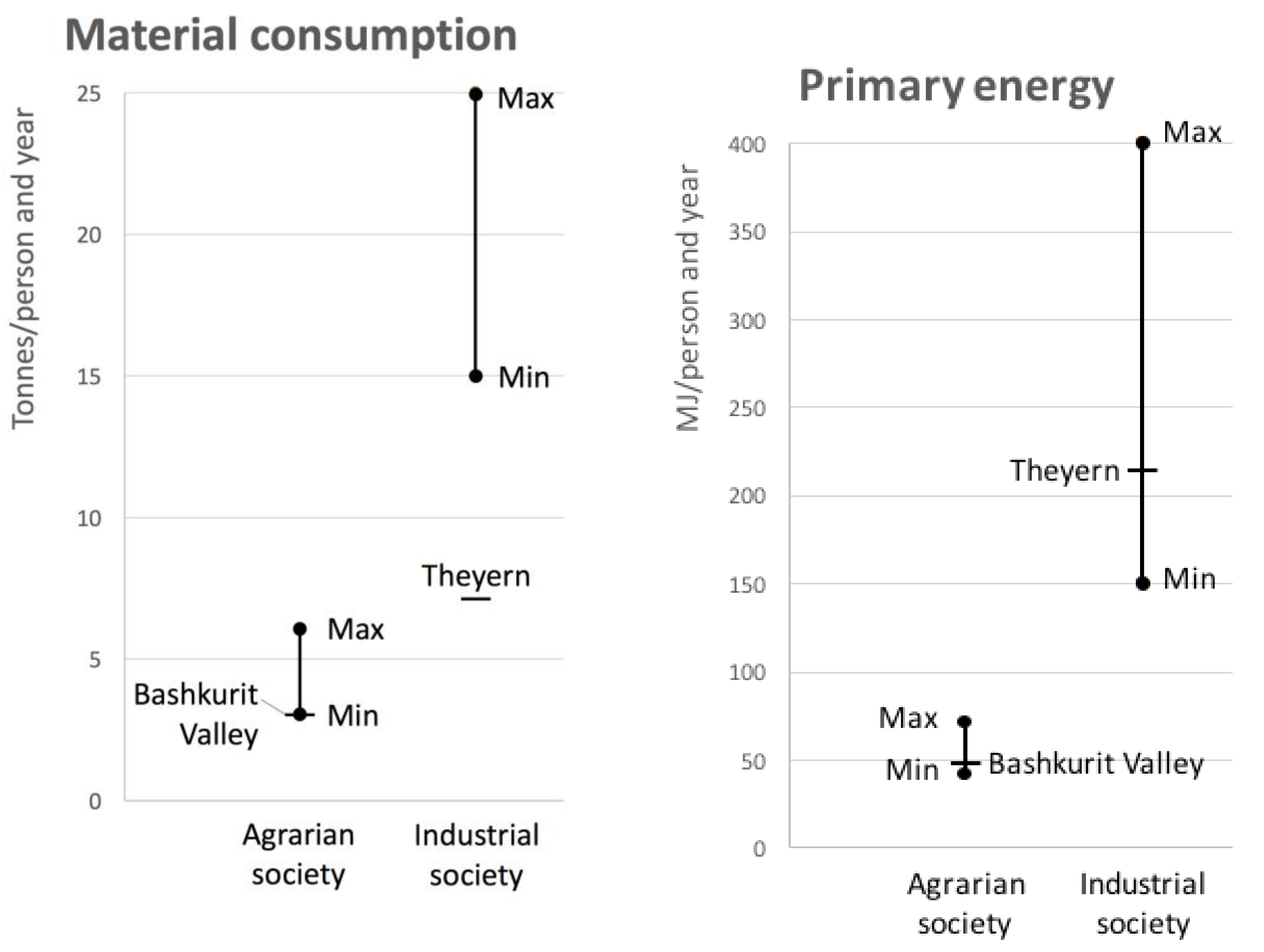


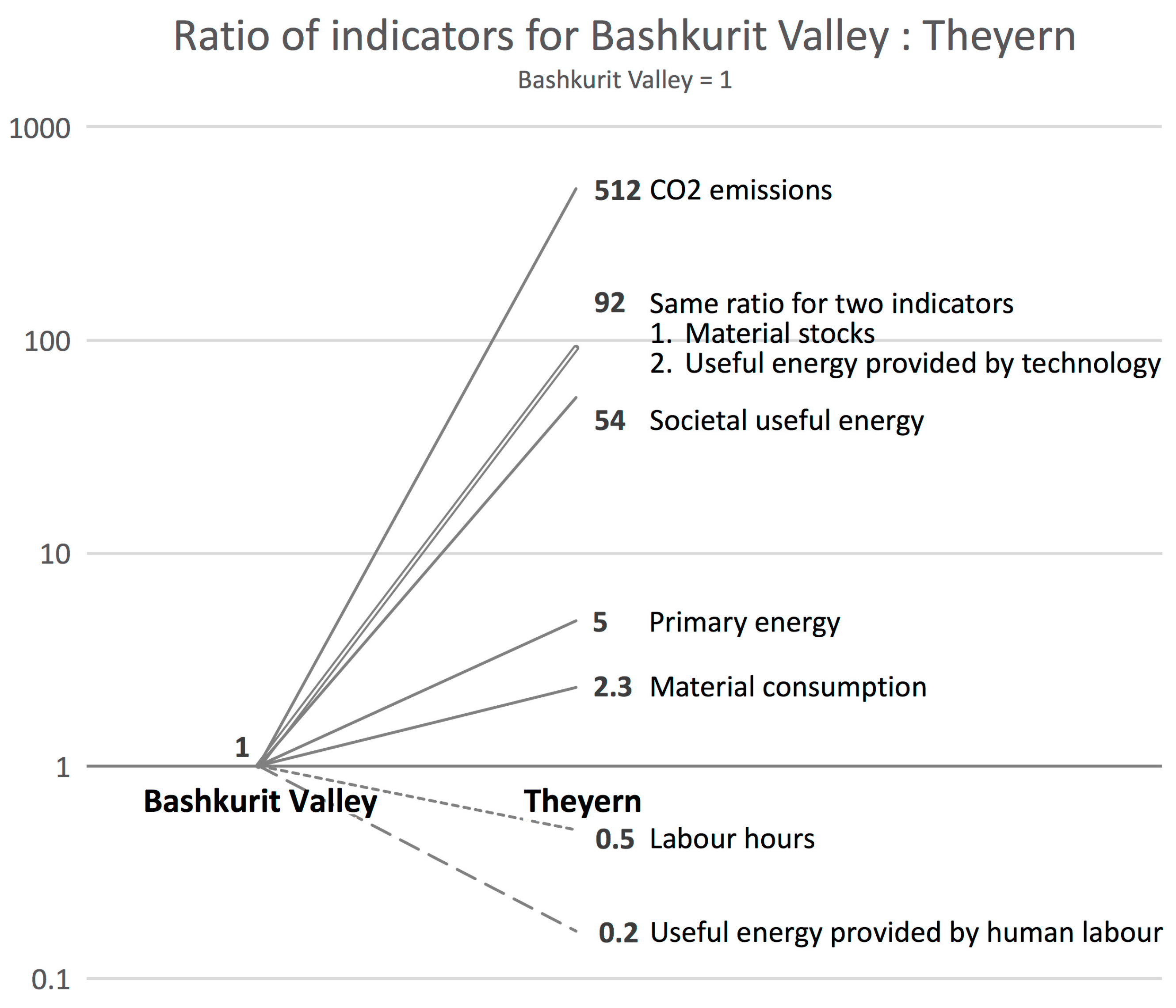
| Category (kg per Person and Year) | Extraction | Imports | Exports | Consumption |
|---|---|---|---|---|
| Biomass | 3190 | 135 | 280 | 3045 |
| Mineral materials | 2 | 15 | 4 | 13 |
| Fossil energy carriers | 0 | 3 | 0 | 3 |
| Artefacts | 0 | 12 | 0 | 12 |
| Total | 3192 | 165 | 284 | 3073 |
| Hour | Daily Activity |
|---|---|
| 5:30 | Most people get up around 5:30 a.m. Women often rise earlier than men. After completing their personal hygiene (PS), women walk to fetch water (HS), visit the nearby church to pray (CS), prepare breakfast, take care of children, grind grains using stones, and do other domestic chores (HS). Girls help the women (HS), visit a nearby church to say their prayers (CS), clean the cattle pen, prepare dung cake, scare away wild animals from fields or travel to the market to sell firewood and dung cake (ES). Men feed cattle, maintain farm tools (ES), or look after children (HS). The boys fetch water, mind the younger children (HS), protect crops from wild animals, travel to the market and feed the cattle at home (ES). These activities usually extend to breakfast time. |
| 7:30 | Except on fasting days, breakfast is taken from 7:30 to 8.00 a.m. After breakfast, women milk cows, clean cattle pen, prepare dung cakes, herd the cattle, walk to the market, work in farm fields, perform wage work or handcraft (ES), participate in public meetings, engage in communal works (CS), and prepare lunch (HS). Men work in the fields, herd cattle, undertake wage work or handcrafting, go to the market (ES), and participate in public meetings and communal works (CS). School is open in two shifts, one in the morning and the other in the afternoon. Some children attend school after breakfast (PS), while others work with parents (ES). |
| 12:30 | Lunch is usually taken from 12:30 to 1:30 p.m. |
| 1:30 | After lunch, the women engage in herding, work in the fields, milk cows, perform handicraft (ES), collect firewood, fetch water, go to grinding mills, care for children, prepare dinner, and other domestic chores (HS), visit relatives and attend festivals (CS). Men work in the fields, go to the market, herd, undertake maintenance work, perform wage work (ES), do communal work, attend public meetings, visit relatives, attend festivals (CS) and have an infrequent leisure hour (PS). The time after lunch is school time (PS) for some children, while others mind the younger children, go to a grinding mill, collect firewood, perform domestic chores (HS), work in the fields, herd cattle, go to the market (ES), and perform communal work, visit relatives, play games, and sometimes attend festivities (CS). |
| 6:00 | Most people return from outdoor work around 6:00 p.m. Darkness sets in, lamps are lit. Women prepare dinner, milk cows, and breastfeed children (HS), while the girls study (PS) and some of them help their mothers (HS). Men carry out maintenance work (ES), while boys study (PS) and feed cattle in the compound (ES). |
| 8:00 | Dinner time is usually from 8:00 to 9:00 p.m. (earlier for younger children). After that, married couples may take a rest and discuss the day (PS) and prepare for the next day (HS, ES). Women grind grains using stone grinds, care for children (HS) and make baskets (ES). Some children study, while others take a rest and have a conversation (PS). With these activities, people usually conclude their day. |
| 10:00 | People go to sleep between 10:00 and 11:30 p.m. |
| Primary Energy (MJ Per Person and Year) | Useful Energy (MJ Per Person and Year) | Conversion Efficiency | ||
|---|---|---|---|---|
| Food | 5000 | Human labour | 300 | 0.0600 |
| Fodder | 30,000 | Animal labour | 120 | 0.0040 |
| Fire wood and cow dung | 9000 | Heat for cooking 1 | 550 | 0.0610 |
| Petroleum | 200 | Lighting | 30 | 0.1500 |
| Total | 44,200 | 1000 | 0.0220 |
| Category (kg Per Person and Year) | Extraction | Imports | Exports | Consumption |
|---|---|---|---|---|
| Biomass | 12,000 | 1400 | 8400 | 5000 |
| Mineral materials | 0 | 600 | 0 | 600 |
| Fossil energy carriers | 0 | 1400 | 0 | 1400 |
| Total | 12,000 | 3400 | 8400 | 7000 |
| Primary Energy (MJ Per Person and Year) | Useful Energy (MJ Per Person and Year) | Conversion Efficiency | ||
|---|---|---|---|---|
| Food | 15,000 | Human labour | 50 | 0.0030 |
| Fodder | 20,000 | Animal labour | 5 | 0.0003 |
| Fuel for tractors and trucks | 55,000 | Driving power agriculture | 5300 | 0.0960 |
| Fuel for cars and motor bikes | 30,000 | Driving power private use | 2800 | 0.0930 |
| Energy for cooking | 8000 | Heat for cooking | 2400 | 0.3000 |
| Oil (30%) + Biomass (70%) for space heating | 64,000 | Space heating | 37,000 | 0.5780 |
| Hydro power & Fossil energy carriers (Austrian mix) | 20,000 | Lighting, appliances, electronic devices | 6000 | 0.3000 |
| Total | 212,000 | 53,555 | 0.2520 |
© 2017 by the authors. Licensee MDPI, Basel, Switzerland. This article is an open access article distributed under the terms and conditions of the Creative Commons Attribution (CC BY) license (http://creativecommons.org/licenses/by/4.0/).
Share and Cite
Haas, W.; Andarge, H.B. More Energy and Less Work, but New Crises: How the Societal Metabolism-Labour Nexus Changes from Agrarian to Industrial Societies. Sustainability 2017, 9, 1041. https://doi.org/10.3390/su9071041
Haas W, Andarge HB. More Energy and Less Work, but New Crises: How the Societal Metabolism-Labour Nexus Changes from Agrarian to Industrial Societies. Sustainability. 2017; 9(7):1041. https://doi.org/10.3390/su9071041
Chicago/Turabian StyleHaas, Willi, and Hailemariam Birke Andarge. 2017. "More Energy and Less Work, but New Crises: How the Societal Metabolism-Labour Nexus Changes from Agrarian to Industrial Societies" Sustainability 9, no. 7: 1041. https://doi.org/10.3390/su9071041





